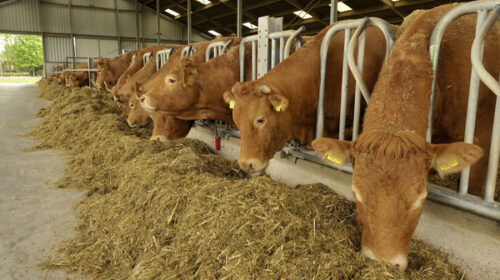The global feed phytogenic market is projected to record a CAGR of 9.20% during the forecast period due to the increasing demand for natural feed additives
The global feed phytogenic market is projected to exhibit a CAGR of 9.20% during the forecast period of 2021 to 2028.
the research report on the Global Feed Phytogenic Market, 2019–2028 has recognized the following companies as the key players in the global feed phytogenic market:Biomin GmbH (Austria), Cargill, Incorporated (US), DuPont (US), Kemin Industries, Inc. (US), Bluestar Adisseo Company (China), Phytobiotics Futterzusatzstoffe GmbH (Germany), Synthite Industries Ltd. (India), The Himalaya Drug Company (India), Pancosma (Switzerland), ostofarm GmbH (Germany), Delacon Biotechnik GmbH (Austria), NOR-FEED (France), Phytosynthese (France), IGUSOL S.A. (Spain), Natura Feed Ingredients (US), Silvateam S.p.a. (Italy), NUTREX BE (Japan), A&A Pharmachem Inc. (Canada), and Natural Remedies (India).
Market Highlights
The global feed phytogenic market is projected to be valued at USD 1,620.76 million by 2028, recording a CAGR of 9.20% during the forecast period. Increased demand for natural feed additives and a negative preference towards feed antibiotics are likely to support the growth of the global feed phytogenic market. The emergence of new technologies such as encapsulation and increasing demand for organic and safe meat is expected to create lucrative opportunities during the review period.
Segmental Analysis
The global feed phytogenic market has been segmented based on type, function, livestock, and region.
By type, the market has been divided into essential oils, herbs & spices, oleoresins, and others. The essential oils segment accounted for the largest market share in 2019, whereas the herbs & spices segment is expected to record the highest CAGR of 9.34% during the forecast period. One of the most common feed phytogenic is essential oils. The consumption of essential oils helps in a variety of ways, including antimicrobial, antioxidants, and digestive stimulant activities.Apart from these, it also positively affects growth performance, gut health, and meat quality. The essential oils exhibit high antioxidant activity attributed to their two main phenols, carvacrol and thymol. They are widely used in poultry nutrition due to their ability to maintain good metabolism.
Based on function, the global feed phytogenic market has been classified as performance enhancer, palatibility enhancer, and others. The performance enhancer accounted for the largest market share in 2019. Phytogenic feed additives are also known as natural performance enhancers. The growth-promoting properties of feed phytogenic such as essential oils, herbs & spices, and oleoresins are expected to drive the market demand. Essential oils have the potential to increase the palatability of diets, thus stimulating voluntary feed consumption in livestock. Also, the addition of phytogenic additives to diets increased feed intake in the lactation period. Furthermore, a study conducted by Biomin showed that Biomin P.E.P., a phytogenic formula with a blend of essential oils and fructooligosaccharides (FOS), reduced biogenic amines’ levels and ammonia, as well as the contents of volatile fatty acids, in the caecum and colon.
Based on livestock, the global feed phytogenic market has been classified as poultry, swine, ruminants, aquaculture, and others. The aquaculture segment is projected to exhibit a higher CAGR during the forecast period. Aquaculture is also referred to as fish farming. In this, fish, shellfish, algae, and other organisms are cultivated under controlled conditions. The increasing demand for fish meal and fish oil is expected to cater to the demand for feed phytogenic in aquaculture. According to the report published by FAO, aquaculture is the fastest-growing food production sector and is projected to reach over 109 million tons by 2030.
Regional Analysis
Geographically, the global feed phytogenic market has been categorized as North America,Europe, Asia-Pacific,Rest of the World. As per CRI analysis, Europe constituted a dominant share of the feed phytogenic market in 2019. The feed industry in Europe has grown significantly in the last few years. Countries such as Spain, Russia, France, and Germany are the major contributors in this region, making a noticeable mention in the top 10 animal feed-producing countries. Also, the market in North America is an attractive region for the manufacturers of feed phytogenic. In North America, the US is the major contributor to the growth of the feed phytogenic market and is the second-largest feed-producing country across the globe. In 2017, the Food and Drug Administration (FDA) brought in new rules sharply curtailing the routine use of antibiotics on farms across the US.The Asia-Pacific feed phytogenic market is projected to register the highest CAGR of 9.72% during the forecast period.
Key Findings of the Study:
-
- The global feed phytogenic market is projected to register a growth rate of 9.20%from 2021 to 2028.
-
- The essential oils segment is estimated to retain its prominent share till2028whereas, the herbs & spices segment is projected to record the highest CAGR of 9.34% during the forecast period.
-
- The performance enhancer segment accounted for the largest market share in 2019 and is expected to grow at a rate of 9.22% during the forecast period.
-
- The poultry segment is estimated to retain its dominant share till2028, whereas the aquaculture segment is estimated to register a growth rate of 9.37%during the forecast period.

